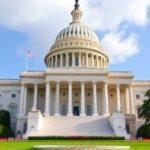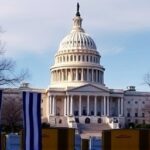Washington, D.C. – With just weeks remaining before critical Affordable Care Act subsidies expire at the end of 2024, Congress is mired in a partisan stalemate that could strip health insurance from millions of Americans. The enhanced premium tax credits, introduced during the COVID-19 pandemic, have driven record marketplace enrollment to over 21.4 million people for 2025 – a 25% surge from the previous year. Without swift action, experts warn of premium hikes averaging 75% or more, potentially pricing out low- and middle-income families from essential coverage.
Record ACA Enrollment Surge Thanks to Subsidy Enhancements
The Affordable Care Act‘s marketplace has experienced unprecedented growth, largely fueled by the temporary subsidies enacted under the 2021 American Rescue Plan Act. These provisions expanded eligibility for premium tax credits, capping contributions at 8.5% of household income for the lowest earners and eliminating them entirely for those below 150% of the federal poverty level.
According to the Centers for Medicare & Medicaid Services (CMS), open enrollment for 2025 shattered records with 24 million sign-ups during the period, including 21.4 million in the 50 states plus D.C. This boom represents a lifeline for families who previously found health insurance premiums unaffordable. For instance, the average monthly premium after subsidies dropped to just $64 nationwide, compared to $477 without assistance.
- Key Stats: Enrollment up 6.4 million from 2024; 80% of enrollees receive subsidies averaging $705 monthly.
- States like Florida (3.8 million enrollees) and Texas (2.5 million) saw massive gains, despite lacking state-based exchanges.
- Demographic shifts: Young adults under 35 now comprise 38% of new sign-ups, reversing pre-subsidy trends.
“These subsidies have been a game-changer, making health insurance accessible for working families who were one illness away from financial ruin,” said Dr. Elena Ramirez, health policy director at the Kaiser Family Foundation. Her analysis shows that without extension, 4 million could lose coverage entirely by mid-2025.
Partisan Battle Lines Harden in Congress Over Subsidy Extension
The gridlock stems from deep divisions in Congress, where Democrats champion a clean extension of the Affordable Care Act subsidies, while Republicans insist on pairing it with reforms to curb costs and alleged waste. House Speaker Mike Johnson (R-La.) has repeatedly stated that any deal must address “Obamacare’s fundamental flaws,” including work requirements and limits on federal spending.
Democrats, led by Senate Majority Leader Chuck Schumer (D-N.Y.), argue that the subsidies are non-partisan successes. “We’ve seen lives saved and premiums slashed – this isn’t the time for political games,” Schumer declared during a recent floor speech. A bipartisan Senate bill, the Enhancing Rural Health Access Act, proposed a two-year extension but stalled in committee amid GOP demands for Medicaid cuts.
In the House, the Energy and Commerce Committee held heated hearings last week, where Rep. Frank Pallone (D-N.J.) clashed with Ranking Member Brett Guthrie (R-Ky.). “Extending these subsidies without reforms is fiscal insanity,” Guthrie retorted, citing Congressional Budget Office estimates of $335 billion in costs through 2031.
“Congress must act now or face a health care catastrophe. The Affordable Care Act subsidies aren’t perfect, but they’re working.” – President Joe Biden, in a White House statement on November 15, 2024
Negotiations have sputtered, with no votes scheduled before the December 31 deadline. Fiscal hawks in the Freedom Caucus threaten to tank any bill lacking deeper health policy overhauls, prolonging the impasse.
Real-World Impacts: Families and Providers Prepare for Premium Shock
Across the U.S., the looming expiration of Affordable Care Act subsidies is already casting shadows on health insurance decisions. In rural Ohio, single mother Lisa Hargrove, 42, relies on her $120 monthly premium plan. “If subsidies end, it’ll jump to $650 – that’s my rent,” she told reporters outside a Cleveland enrollment fair. Stories like hers are multiplying, with advocacy groups reporting a spike in anxiety calls.
Health economists project dire consequences:
- Premium Spikes: CBO models predict average increases of 75-91% for subsidy-dependent enrollees, with some facing 150% hikes.
- Coverage Losses: Up to 5.1 million could go uninsured by 2026, per Urban Institute forecasts, exacerbating hospital uncompensated care costs by $50 billion annually.
- State Variations: Expansion states like California may mitigate via state funds, but non-expansion red states face steeper drops – Texas alone risks 900,000 dropouts.
Providers are bracing too. The American Hospital Association warns of strained emergency rooms as preventive care dips. “Uninsured rates climbing means more bankruptcies and worse health outcomes,” said CEO Rick Pollack.
Ripple Effects on Small Businesses and Employers
Small businesses offering Affordable Care Act-compliant plans could see costs soar, prompting shifts to high-deductible options. A National Federation of Independent Business survey found 62% of owners plan to drop coverage if subsidies lapse, shifting burden to public programs.
Lame-Duck Session Drama: Deadlines and Bipartisan Hopes
As the lame-duck session unfolds post-election, pressure mounts on lawmakers. The Senate Parliamentarian ruled last month that subsidies could be attached to must-pass spending bills via budget reconciliation, bypassing filibusters – a tactic Democrats eye eagerly. However, incoming Republican Senate control in January complicates matters.
Bipartisan moderates like Sens. Susan Collins (R-Maine) and Mark Warner (D-Va.) are pushing a compromise: a one-year extension tied to transparency measures on subsidy usage. “We can thread this needle if egos step aside,” Collins said in an interview with The Hill.
Yet, procedural hurdles abound. The House recessed early amid debt ceiling fights, delaying key health policy debates. Lobbyists from AARP and Blue Cross Blue Shield flood Capitol Hill, delivering petitions signed by 1.2 million advocating for extension.
- Timeline Pressure: Final open enrollment ends January 15; subsidy cliff hits fully in 2026 plans.
- Alternative Paths: Executive actions floated by HHS Secretary Xavier Becerra include auto-renewal grace periods, but can’t replace legislation.
- Public Sentiment: Polls show 68% favor extension, per KFF tracking.
Long-Term Health Policy Shifts on the Horizon
Beyond the immediate crisis, the Affordable Care Act subsidy saga underscores broader health policy fault lines. Republicans, emboldened by election gains, tout alternatives like expanded health savings accounts and short-term plans. Project 2025 outlines propose repealing enhancements outright, redirecting funds to state block grants.
Democrats counter with visions of permanent codification, potentially via Build Back Better remnants. Economists like Jason Furman argue extension could save $100 billion in long-term costs by preventing uninsured-driven ER overuse.
Stakeholders watch closely: Insurers like UnitedHealth report profitability from high enrollment but warn of adverse selection if healthy enrollees bail. Consumer advocates push for permanence, citing 90% satisfaction rates among subsidized users.
As negotiations intensify, the stakes couldn’t be higher. Failure to act risks unraveling a decade of health insurance gains, thrusting millions back into pre-ACA vulnerability. Lawmakers face a pivotal choice: bridge divides for continuity or risk a coverage collapse that defines the next Congress. With holiday recesses looming, all eyes turn to potential breakthrough deals before the New Year.









